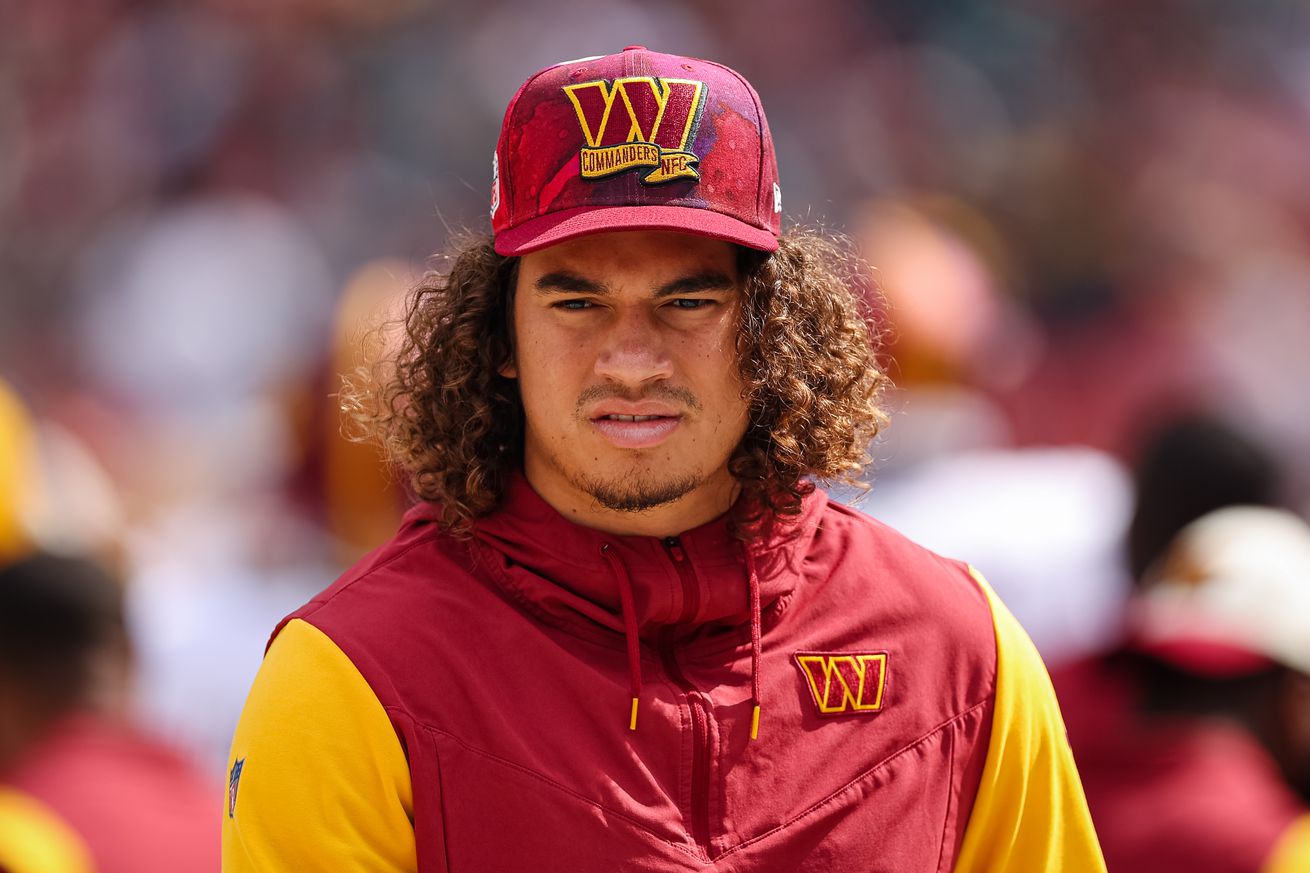
What are the chances Cole Turner breaks out in 2023?
If you have been around Washington football fans long enough in recent decades you may have noticed an annual cycle. Starting in the offseason, with free agency and the draft, the fanbase begins to build expectations about how the team will be improved in the coming season. These expectations tend to be based more on hope than on reason. As the seasons have unfolded during Dan Snyder’s tenure as owner, more often than not, hope has given way to despair. Despite the annual ritual of predicting 10+ wins, Washington fans have only enjoyed two winning seasons in the past 10 years, and one of those was 8-7-1.
Setting unreasonable expectations is a recipe for disappointment. Therefore, as a service to the fanbase, for the past two seasons I have taken it upon myself to assist Hogs Haven readers with setting reasonable expectations for the incoming rookie class. This season I have decided to go one step further by examining the statistical reality of the hype surrounding a few of Washington’s returning players. Stemming from an exchange I had earlier in the offseason with regular HH commenter, OffseasonOptimist, I have decided to badge this series The Offseason Skeptic.
I will kick off the series by examining the hype which has developed through organized team activities about the prospect that second-year tight end Cole Turner will break out in 2023. Turner was selected by Washington 149th overall in the fifth round of the 2022 draft. His rookie campaign got off to a promising start when reports emerged in training camp that he was developing chemistry with starting QB Carson Wentz, who was well known to have an affinity for large receivers.
Unfortunately, Turner developed a hamstring injury in preseason practice and was sidelined until Week 5 of the regular season when he made his debut, playing 32 offensive snaps, with three targets but no receptions. The following week, Turner got his first NFL start against Chicago, replacing injured starter Logan Thomas, and notched his first two receptions for 23 yards on two targets. Injury struck again the next week against the Packers, causing Cole to miss the next three games in the concussion protocol.
Cole finished his rookie season having played a total of 245 offensive snaps in 10 games. With those playing opportunities, he was only able to draw quarterbacks’ attention to become a passing target nine times. The two passes he caught against Chicago were his only receptions of the season. His final stat line was as follows:
10 Games, 2 Starts, 245 Offensive Snaps, 9 Targets, 2 Receptions (22.2% catch rate), 23 Yards, 0 TD, 0 Drops
If that production rate strikes you as low, even allowing for time lost to injury, that’s because it is. Of 27 rookie tight ends in 2022, Turner played the 13th most offensive snaps, placing him about middle of the pack in playing time. He had the 19th fewest targets and the 18th fewest receiving yards, both slightly below class median. He was further behind his classmates in attracting targets, ranking 22nd out of 27 rookies, with targets on only 3.7% of offensive snaps (median = 6%), and in catching the ball. His 22.2% catch rate ranked 20th in the class (median = 64.6%, high = 100%, James Mitchell 11/11 targets).
Despite the rather inauspicious start to his career, hope is building within the Washington fanbase that Turner will turn the corner and ball out in 2023. To see how reasonable those expectations are, this article will have a look at how often tight ends who had rookie performances like Cole have gone on to have successful NFL careers. But before we get to that, I thought it would be informative to have a look at the developmental timelines for tight ends.
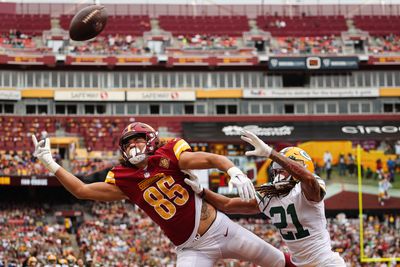
Photo by Scott Taetsch/Getty Images
TE Development Timelines
Hogs Haven’s KyleSmithforGM has highlighted the fact that top-tier tight ends take longer to develop than other offensive skill positions. Turner’s low rookie production might not mean much if some of the league’s top tight end had similar slow starts. To put Turner’s numbers in context, I had a look at the developmental timelines of top tier and middle tier tight ends over the last decade or so.
In my previous article on offensive linemen, I observed that players drafted in the first two rounds often have the opposite of the expected development trajectory. They frequently start as rookies, then lose their starting positions over time. This suggests that many players drafted early get their starts by virtue of draft position, rather than earning them. To prevent any draft position effect from contaminating the results, I only looked at tight ends drafted after the second round.
This had an unexpected effect of greatly reducing the pool of players available for analysis. Despite what you may have heard, a high proportion of the NFL’s quality starting tight ends were drafted in Rounds 1 and 2. For example, 4 of the 8 All-Pro tight ends from 2013 to 2022 were first and second-round picks. Furthermore, in the last three seasons, 6, 6 and 5 of the top 10 tight ends by receiving yards were first and second rounders. Despite the reduced numbers, there were still enough players to work with.
Elite Tight Ends and Quality Starters
Since expectations for Cole are running high, let’s start with top-tier tight ends, drafted after the second round. Since numbers were small, after eliminating first and second-round picks, I combine Elite Players and Quality Starters. My criterion for Elite Players was tight ends drafted from 2010 to 2022 who have been voted first or second team All-Pro (AP, PFWA or SN) or Pro Bowl starters. To pick up Quality Starters, who fell short of the elite ranks, I also included any tight ends drafted or signed as UDFAs from 2010 to 2022 who were in the top 11 (approximating top 1/3) in receiving yards within their first three seasons or twice in the past five years and were not already included in the elite group.
These criteria yielded the following players:
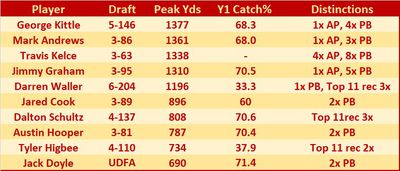
None of the top-tier tight ends had catch rates as low as Cole Turner in their first NFL seasons. Darren Waller started his career with Baltimore at WR and had fairly similar rookie season production to Turner, catching 2 of 6 targets for 18 yards and a catch rate of 33.3%. Travis Kelce played one special teams snap and then spent the rest of his rookie season on injured reserve. In his first season playing, he caught 77% of his targets for 862 yards.
Now, let’s have a look at how these players developed as receivers in the first six years of their NFL careers.
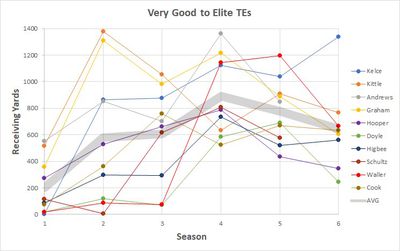
This graph is a little messy, because there is a huge amount of variation, particularly in the first three years of the tight ends’ careers. Nevertheless, some key points emerge. First, only five of the 10 top tier tight ends had fewer than 100 receiving yards as rookies. One of those was Travis Kelce who was injured and debuted with 862 receiving yards the following season. Only two of the top-tier tight ends who played as rookies had fewer receiving yards than Turner: Jack Doyle 5 rec/19 yds, Darren Waller 2 rec/18 yds.
While some of these players took a few seasons to take off, 7/10 had over 600 receiving yards by their third seasons. All 10 had over 500 receiving yards by their fourth seasons, which is when the group average peaked. The best of the group, Travis Kelce, had his highest receiving total in 2022, his 10th season in the league.
To this point in his career, it appears that Cole Turner is behind the pace of the best later-round TEs in the past decade. But it is still early, and he has plenty of time to catch up like Jack Doyle or Darren Waller. It might be a little unfair to place those expectations on a fifth-round draftee, so let’s see how he compares to some Solid Starters instead.
Solid Starters and Role Players
The next group of players was intended to take in tight ends who have become solid starters, but have never really distinguished themselves as receivers. This might include tight ends who are primarily blockers, such as the Commanders’ John Bates. The inclusion criteria were: UDFA singings or players drafted after Round 2 from 2010 to 2019, top 12 to 21 in receiving within their first three seasons or for two or more seasons in their careers, full-time starters ( > 8 starts in a season) for at least two seasons, not included in the Elite and Quality Starters group. Unlike the previous group, the draft year cutoff was set to 2019 to make sure we are looking at players who have been in the league long enough to develop into starters.
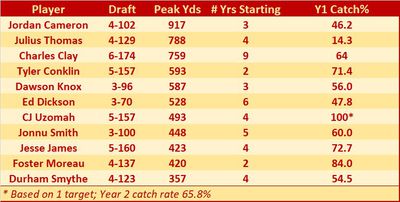
As it turned out, these criteria turned up a mix of solid starters, such as Charles Clay, and players who have split time between starting and TE2 to TE3 roles. More of these players were drafted in the fifth and sixth rounds than in the previous group. Only one out of 11 players had a catch rate lower than Cole’s as a rookie and none of the others was particularly close. Now, let’s see how the developmental timelines compare.
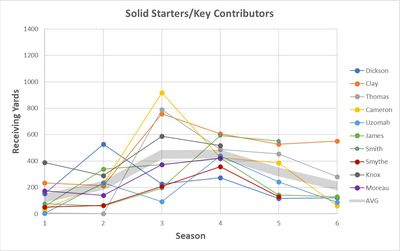
This graph is plotted with the same vertical scale as the previous one to facilitate comparison. This group put up lower receiving totals than the Elite and Quality Starters, and they were also more likely to peak in their third or fourth seasons. As with the previous group, all of these players had matured as receivers by their fourth seasons. Six of 11 players in this group were fairly static between Years 1 and 2 of their careers and then improved significantly in Year 3.
Two of 11 players in this group had lower receiving totals than Turner as rookies (Thomas 5 yds, Uzomah 4 yds). Jordan Cameron was pretty close with 33 receiving yards.
While the comparisons thus far have not been overly encouraging regarding Cole’s prospects, he is still young and there is plenty of time for him to break out.
Players with Similar Rookie Seasons to Cole
While Turner’s receiving totals as rookie might not be particularly alarming, what may be more of a concern was his failure to capitalize on opportunities when he got playing time. In particular, he had a low rate of targets as a receiver, and when Washington’s quarterbacks did throw him the ball, he had a low catch rate. One might be tempted to chalk up the catch rate to the fact that Washington’s quarterbacks were not the most accurate throwers. However, Curtis Samuel, Terry McLaurin and Jahan Dotson managed to achieve catch rates of 69.6%, 64.2% and 57.4% receiving passes from the same quarterbacks. So, it would seem that the issue was with Cole.
Let’s see how tight ends with similar catch rates and target rates to Cole as rookies have fared in the NFL. To find comparable players, I first searched for tight ends signed as UDFAs or drafted from 2010 to 2019, who played in 8 or more games as rookies and had catch rates below 30%. In this case, I didn’t deliberately exclude players drafted in Rounds 1 and 2. That didn’t make any difference, because none turned up. The players retrieved by these criteria were as follows:

There aren’t a lot of household names here. Aside from Dennis Pitta, none of these players had more than 175 receiving yards in a season. Only three of them managed to become full-time starters for a single season, and five of eight were out of the league in under five years. To give you an idea how good, or not, these players were over their entire careers, in the last column I listed career Approximate Value (AV) divided by number of years in the league. For comparison, an AV of 4 means a player had a decent, if unspectacular season. An AV of 1 means he hardly showed up.
Based on catch rate in his rookie season, Cole didn’t exactly place himself in lofty company. How about his rate of targets? He had a huge opportunity when Logan Thomas miss time with injury. Did he at least show a promising ability to draw targets? To see how players with a similar rate of targets as rookies have fared in the NFL, I searched up all first-year tight ends from 2010 to 2019 who played at least 8 games and had roughly comparable target rates. To ensure I got a decent sized sample, I set the upper limit at 20% above Cole’s target rate (4.4% of snaps) and set the lower limit at half of his target rate (1.8% of snaps). Once again, I ignored draft position.
Let’s take a look at Cole’s comparable players:
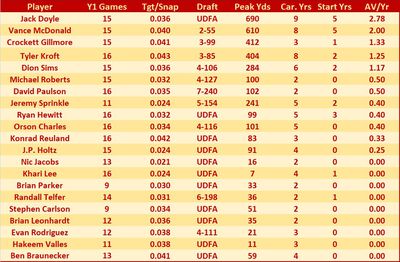
Topping the list is two-time Pro Bowler, Jack Doyle, so that’s a good start. Doyle had three good seasons in a nine-year career and was fairly pedestrian the rest of the time. Next on the list is 2nd round pick, Vance McDonald, who was a solid starter for San Francisco and Pittsburgh, and had one very good season (610 yds, 4 TDs, 33 1st downs) in 2018. Other than those two, the only other players that Washington fans are likely to remember are former Redskins Jeremy Sprinkle and J.P. Holtz.
Overall, one of the 22 tight ends with a comparable rate of targets as a rookie made the Pro Bowl twice. One became a solid, full-time starter for most of an eight year career, with one very good season. Two more were primarily backups and each managed one season above 400 receiving yards. The other 18 players ranged from career backups to fringe-roster players with short careers.
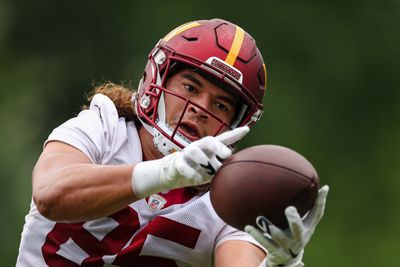
Photo by Scott Taetsch/Getty Images
What Does the Future Hold for Cole Turner?
Despite playing for a team with one of the weakest TE groups in the NFL in 2022, Cole Turner really failed to distinguish himself in his rookie season. Turner’s lack of production as rookie might not concern many fans, because he missed time to injury and it is well known that tight ends often take a while to catch on in the NFL. Some of the better tight ends in the league, taken on Day 3 of the draft, got off to slow starts as rookies, including Darren Waller (18 rec/178 yards through first three years), Dalton Schultz (13 rec/122 yards in first two years) and Tyler Higbee (11 rec/85 yards rookie season).
While Turner missed a fair amount of time to injury as a rookie, he still managed to see the field for 245 offensive snaps in 10 games. What should be a concern is his failure to take advantage of opportunities when he had them. The two stats which best illustrate his failure to take advantage are target rate and catch rate. With few exceptions, tight ends who have had comparable target rates and catch rates in their rookie seasons have not done well in the NFL.
If he can stay healthy through camp and preseason, Turner has a great opportunity to show that his rookie season was a fluke. If he does manage to breakout in 2023 as some are suggesting, Commanders fans should appreciate what a remarkable feat he has accomplished. Because few tight ends in the last decade have gone on to have successful NFL careers after such a disappointing rookie season.
